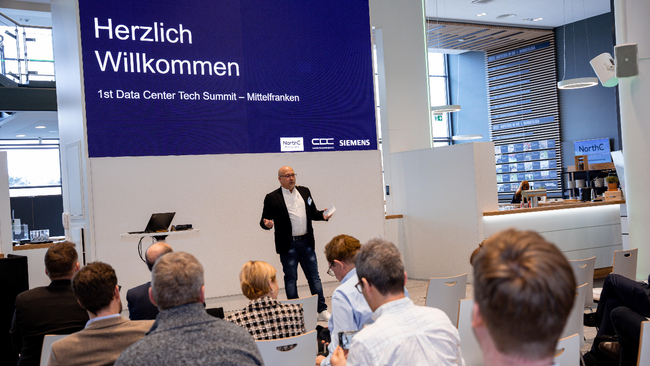How can I design a data centre infrastructure that is both flexible and sustainable? Siemens sought to address this key question of the future by organising its first Data Center Tech Summit in south-east Germany. Siemens, in partnership with Cadolto Datacenter and NorthC Deutschland, hosted a workshop-style discussion with various representatives from the data centre industry to provide a comprehensive answer.
Together with Cadolto, the expert for modular construction in the data centre industry, and NorthC, a provider of regional data centre and colocation services, Siemens invited participants to the workshop in a sports-inspired setting at the stadium of SpVgg Greuther Fürth. During the presentations of the partner companies, the most critical challenges facing data centre operations became clear. The scalability of the infrastructure, along with energy efficiency, is an obstacle on the path towards achieving an efficient data centre. Moreover, security, encompassing both physical safety and data protection and compliance, is a key requirement for data centres. The automation of data centres represents a real challenge to decision-makers and demands close consideration during the planning and operational stages.
To classify these challenges broadly, participants were asked to envision the data centre of the future from their own professional experience and perspective. This approach allowed for the identification of individual areas of interest and expertise, as well as the categorisation of ideas according to their actual impact and feasibility. This pool of ideas resulted in three main questions. The participants engaged in small group discussions, each focusing on one of the three questions:
- What does efficiency in terms of data centre operation mean to me?
- What factors allow me to achieve the highest level of modularity?
- How can I achieve efficient waste heat utilisation in the long term?
Initial results
Efficient operation: To get closer to answering the initial question, participants divided data centre efficiency into essential areas that individually and collectively contribute to effective data centre operations. Data centre construction and technology were the starting point. Clear specifications and the possibility of ‘second life’ operation were identified as factors that enhance efficiency. Given its current omnipresence, energy is another area that contributes to the effectiveness of data centres. Further, CO2 neutrality, waste heat management, higher operating temperatures and modern cooling technologies were at the top of the agenda of the data centre experts. In the IT sector, the discussion concluded that the focus should be on end-to-end automation and closer coordination between operators and users. To optimize processes, decision-makers should introduce harmonised services, optimise staff deployment, scrutinise the supply chain, review energy management in accordance with ISO 50001 and draw their conclusions from it. Sensible capacity management is also crucial when it comes to operating a data centre efficiently. The participants identified modular growth and well-thought-out near-field planning as key factors for this. From the point of view of the participants, defining various KPIs is essential for measuring efficiency. Selecting the right measuring points and implementing data-based optimisation in real time are key to achieving this goal. To bring together all these areas, a guiding sustainability mindset and cross-divisional teamwork are absolutely crucial.
Modularity: When identifying the factors that influence modularity, this workshop team identified not only external preconditions, such as property and electricity, but also overall operational management, including (acquisition) costs. Moreover, the participants also emphasised how important it is for IT managers to exchange ideas with their building services counterparts. Yet another factor is the development of a distributed infrastructure. In data centre planning, a hybrid building, combining both existing buildings and modular data centres, can contribute to modularity. After all, the classification and standardisation of modules are relevant parameters.
Waste heat utilisation: From the point of view of the participants, the consistent implementation of waste heat utilisation is not yet feasible. Key criteria for this are the actual choice of location and the general criteria for use. Based on the results of the discussion, the right political framework conditions and planning principles for waste heat utilisation are not yet in place. The standardisation of components for cooling and waste heat utilisation is a very important factor here. The workshop participants view the secondary use of heat as an independent business model. To maximise year-round waste heat availability, the relocation of transfer points and the establishment of a clear legal framework are essential. Needless to say, service providers that offer waste heat as a service are also needed.
The next step will see Siemens analyse and utilise these findings to create use cases that can, in the best case, establish a new cycle of value creation. Ultimately, this brings data centre operators, planners and decision-makers one step closer to answering the initial question.
Quelle: https://www.lanline.de/datacenter/gemeinsam-die-rz-infrastruktur-von-morgen-gestalten.255684.html
Autor: Anna Molder


